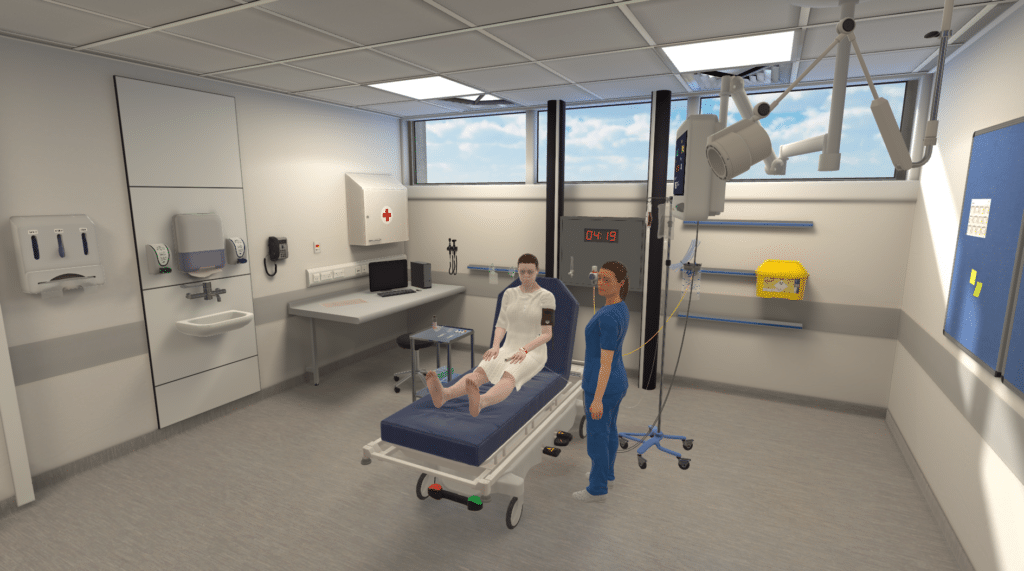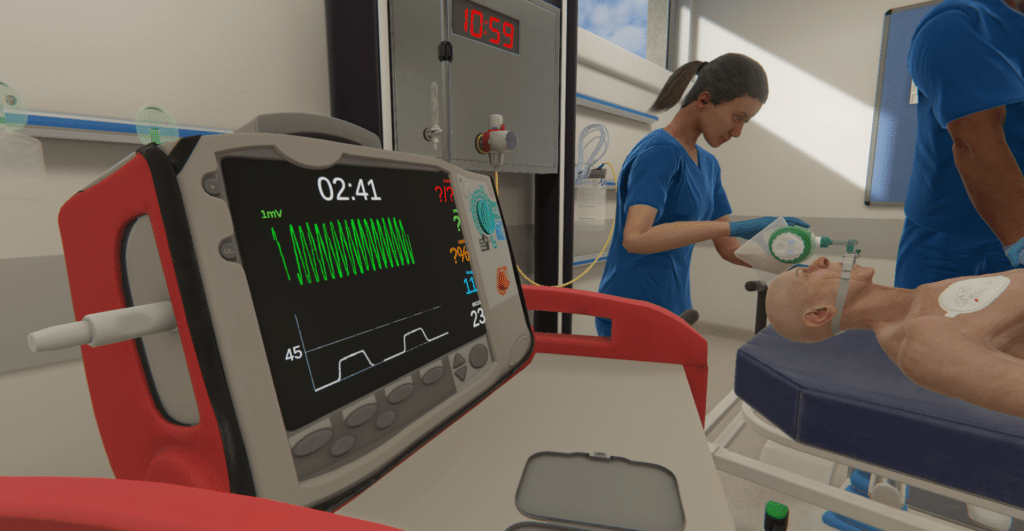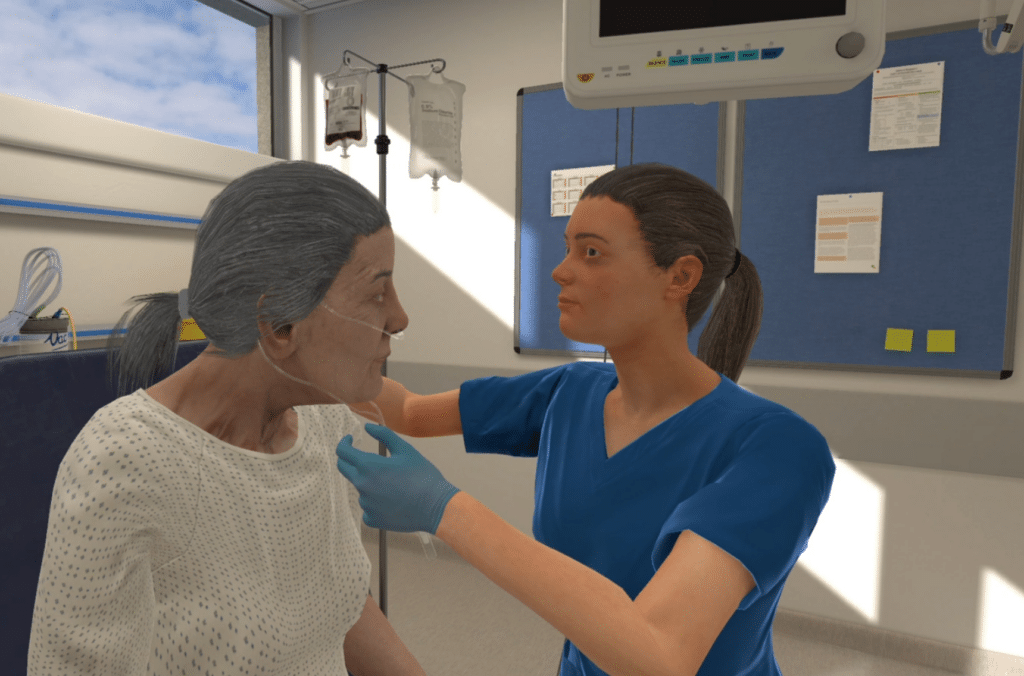‘Tis the season!
Nursing students all across the United States are getting ready for graduation, preparing to sit for the Next Gen NCLEX, and gearing up for the transition to practice.
While a very exciting time, it’s certainly a transition to go from nursing student to practicing bedside nurse.
New nurses need support and mentorship, which is why many elect to move forward in a nurse residency program. And the learning doesn’t stop there (as you likely know!).
Lifelong learning is a hallmark of clinical practice, and with so many new ways to learn, it only makes sense to think about which methods can be carried across a nursing career.
Augmented reality, mixed reality, virtual reality – and now AI – these rapidly-evolving technologies are here to stay, and while you might think that VR is a learning tool for students (and you’d be right about that), it’s a much more robust and flexible tool nurses can take with them throughout their practice.
From the beginning stages of learning nursing fundamentals through exam prep and the transition to practice, VR is undoubtedly supporting nursing students along their journey to licensure.
Once nurses are licensed and practicing, VR can support continuing education with annual competencies and help nurses stay ahead of the curve in gaining knowledge around new advancements in patient care and nurse training.
This article will touch on three main areas where VR can be useful for a new nurse:
- Preparing for the Next Generation NCLEX
- Transitioning to practice in nurse residency
- Refreshing and building clinical skills with ongoing education
Using VR to prepare for the NCLEX
2023 was a big year for the NCSBN, whose researchers created the Clinical Judgment Model – the foundation of the Next Gen NCLEX.
This move is a first in shifting to testing that looks at critical thinking in nursing.
As clinical judgment is a complex cognitive skill, it remains difficult to measure – and even to define.
For the NCSBN, clinical judgment involves layered skill sets that involve the intersection of environmental factors, personal factors, and the ability to recognize, analyze, prioritize, and reprioritize information. All to come to a clinical decision, take action, and measure results.
Where virtual reality fits in
Virtual reality simulations aide this process by immersing soon-to-be nurses in standardized clinical scenarios.
These scenarios can involve any type of nursing specialty, which can be difficult or impossible to reproduce by other methods.
Learners then have the opportunity to direct patient care, using all of their knowledge and applying that to the situation before them.
Single learner scenarios drive critical thinking and clinical judgment, as learners must make all their own decisions based on the information they gather in the room.
They must observe, analyze, formulate, and act in a timely manner to optimize patient outcomes – exactly what a bedside nurse is expected to do on a daily basis.
While each scenario at OMS is already competency-mapped, using an additional feature like Competency Mapping & Tracking can take learning to a new level. Students and educators receive pinpointed data and feedback linked to core competencies of the NGN, individualizing the learning experience.
Students can prepare for practice while gaining greater insight into their strengths and areas needing improvement before they sit for their exam.
To further personalize the learning experience, educators can use the authoring platform, OMS Create, to make small changes, like adjust learner feedback, or completely alter simulations, like tailoring scenarios to hone in on what students need to prepare for their exam.
All this together means an immersive experiential learning opportunity for nursing students to apply their knowledge, use clinical judgment, and ensure they’re on the right track come test time.

VR in nurse onboarding & residency
As nursing students become practicing nurses, an inevitable transition takes place.
It’s a shift in responsibility, and for many new nurses, it’s an added transition to learn the ropes at a new facility.
As student nurses, learners might manage one or two patient cases during a clinical rotation under the guidance and supervision of a clinical instructor or preceptor. However, when they hit the floor as a licensed RN, there’s a greater responsibility in needing to care for multiple people, managing several cases at every shift.
This can be a new experience for freshly-licensed nurses, and considering about 91% of new nurses fall outside the acceptable range of competency, it’s imperative that student nurses transitioning to practice get as much experience as possible to prepare.
Where VR fits in
Getting familiar with a new environment, policies and procedures, and managing patient care are all components of the onboarding process and transitioning to practice.
Virtual reality can facilitate all of those needs, on an individual level, creating a personalized onboarding and residency experience for new nurses.
Customizable scenarios offer the ability to make adjustments and upload facility-specific documents for new nurses to reference within a scenario. This can reduce variation in care and familiarize RNs with the facility’s specific procedures from the very beginning.
Realistic VR scenarios that reflect daily practice can help new nurses to apply critical thinking, building confidence in their clinical skills ahead of hitting the floor.
Multi-patient scenarios, for example, are a set of scaffolding simulations that go from one up to five patients. These scenarios mirror the responsibilities of an RN working a typical shift, caring for multiple patients all at different places in the healthcare journey.
As nursing students rarely have the opportunity to manage multiple patient cases before licensure, these nursing scenarios act as a bridge between education and practice for new nurses.
Critical thinking and clinical decision making skills are at the center of these scenarios, and additional skills, like delegation, prioritization, and time management are needed to effectively and efficiently deliver quality care.
As these types of VR nursing simulations are conducted on an individual basis, feedback and scoring promotes a personalized experience for learners.
Educators are able to use the robust data & analytics to identify areas of strength and improvements needed quickly and objectively.
They are then able to tailor the onboarding or residency experience to the learner’s specific needs.
New nurses can use feedback to reflect and gain insight into their personal clinical performance.
All of these factors together can promote nurse onboarding with individualized learning for new nurses, building confidence in their skills, demonstrating competency, and getting nurses familiar with the policies of their new environment.

VR for nursing competencies
As nurses become more confident and experienced in their practice, their needs shift from building skills to refreshing them – especially for high acuity situations that don’t occur frequently.
Maintaining clinical skills can mean reducing variation in care and staying prepared for emergent clinical situations that can arise at any time.
With the evolving landscape of clinical practice, it’s also imperative that nurses are afforded the opportunity to build new skills like utilizing advancing technology or implementing new clinical treatment methods.
However, it’s particularly difficult to arrange time for nurses on the floor to go into a sim lab and work in a physical simulation environment.
As it can be both time and resource-intensive to run physical simulations, they may not occur with the frequency needed for nurses to feel up-to-date and comfortable in handling low frequency, high stress events.
Where VR fits in
For competencies that occur once every one or two years, like ACLS, it’s important to provide nurses with regular opportunities to train in those situations.
Communication and procedural skills also require ongoing maintenance. While many of the day-to-day clinical encounters require continued application of those skills, it’s equally important to remain prepared for less frequent situations.
In VR scenarios, nurses can practice communication strategies in difficult situations like de-escalation or breaking bad news, and they can do that all in a safe space.
VR scenarios that can be accessed remotely can provide more frequent practice, which eliminates the difficulty in scheduling for physical simulation while providing more opportunities for refresher training.
This, in turn, creates more opportunities to support nurses in their continuing education. Nurses have more frequent training windows, so that they can run simulations independently and at their own pace.
In short, VR simulations provide more training, more often – improving patient outcomes, reducing variation in care, and supporting nurses in their lifelong learning.
